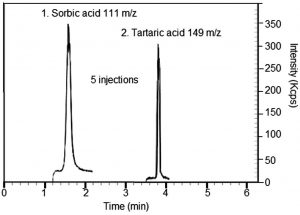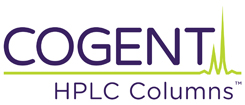Minimal Sample Preparation
This method doesn’t require complex preparation or extraction of the wine samples. It allows detection of both Acids in a short gradient run, with rapid equilibration of the column after each run.
Calibration curves were constructed in the ranges 1–300ppm and 100–3000ppm for Sorbic Acid and Tartaric Acid respectively. Correlation coefficients for both Acids were close to 0.997. In the sample of the Red Wine analyzed, it was determined that the concentration of Sorbic Acid was 8 ppm and Tartaric Acid was 500 ppm.


Peaks:
1. Sorbic Acid 111 m/z
2. Tartaric Acid 149 m/z
Method Conditions
Column: Cogent Diamond Hydride™, 4μm, 100Å
Catalog No.: 70000-15P-2
Dimensions: 2.1 x 150mm
Mobile Phase:
—A: DI Water / 16.5 mM Ammonium Acetate
—B: 90% Acetonitrile / 10% DI Water / 16.5 mM Ammonium Acetate (v/v)
Gradient:
| Time (minutes) | %B |
| 0 | 95 |
| 1 | 95 |
| 4 & 9 | 30 |
| 9.5 | 95 |
Post Time: 3 minutes
Flow rate: 0.4 mL/minute
Detection: ESI – NEG – PerkinElmer Flexar SQ 300 Mass Spectrometer
Injection vol.: 1μL
Sample Preparation: Red and white wine samples were filtered using a MicroSolv Tech Corp. filter (0.45µm, Nylon) and diluted using 50 / 50 / 0.1 Methanol / DI Water / Formic Acid.
t0: 0.9 minutes
Note: Sorbic acid (SA) is used worldwide as a preservative for various food and beverages, including wine. It is used to inhibit yeasts and molds. However, in Sorbate treated wines Lactic bacteria have been found to convert SA to 2-Ethoxyhexa-3, 5-Diene, which gives the wine an unpleasant geranium like smell. Tartaric Acid is a by-product in wine production. It is important to determine the amount of Tartaric Acid in the evaporated powder or after purification.
Attachment
No 278 Sorbic and Tartaric Acids in Wine pdf 0.2 Mb Download File


